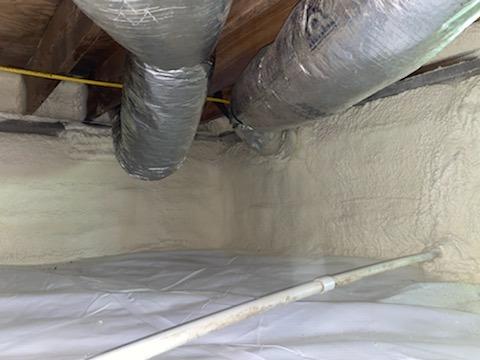Crawl Space Repair Before & After Photos
Click on a photo to enlarge.
Crawl Space Foundation Walls in Chester, VA
The insulation in this crawl space beginning to pull apart and fall to the floor. Fiberglass insulation is not meant to hold moisture, and it loses its value when it becomes damp. Water droplets displace the air in the spaces between the glass fibers, reducing the material's thermal abilities. The wet insulation fibers pull apart and the added weight of moisture causes it to sag and even fall to the crawl space floor, rendering it useless.
Most crawl spaces in our area, like this Chester, VA home have fiberglass insulation between the floor joists. However, this is not an effective solution in our area due to high humidity and warm temperatures over half of the year resulting in high relative humidity, falling insulation, and microbial growth. So instead, the foundation walls were insulated using closed-cell spray foam which acts as an air barrier and vapor retarder, while the home was sealed from the earth’s moisture with CleanSpace, a heavy-duty vapor barrier. The foundation vents were sealed with Foamax foam board and covered over with closed-cell spray foam. Not only does all this protect the crawl space from moisture, with the addition of a dehumidifier it helps control the relative humidity, improves air quality, and reduces energy bills.
Installing a Crawl Space Vapor Barrier in Sandston, VA
These homeowners in Sandston, VA were concerned about moisture in their crawl space. Many areas of the crawl space dirt floor were exposed and efflorescence covered the porous block walls. To address the moisture issues from the foundation walls, we installed a 10-mil CleanSpace Vapor Barrier. This crawl space liner is installed over the crawl space floor, wrapped around each pier, and mechanically attached to the foundation walls above the outside grade. This will help protect the crawl space from the earth’s moisture.
Crawl Space Door Replacement in South Chesterfield, VA
The original crawl space door on this home was a piece of ply-wood that had been damaged by weather over time. It was waterlogged and rotting, and because it didn't have a seal it didn't prevent pests or outside air and moisture from entering the crawl space.
We installed a new crawl space door that will not warp, rust, or rot and is HOA friendly. Behind this door, is a friction-fit door that insulates and air seals behind the exterior door.
Crawl Space Encapsulation in Bruington, VA
This Bruington, VA client contacted us about repairing moisture damage in their crawl space. Moisture had caused mold and mildew growth, was absorbed in the insulation which held it against the floor joists, the material began to delaminate and fall away from the floor.
All debris and insulation was removed from the crawl space, microbial growth was treated, the vents, sill plate, & rim band were sealed, the foundation walls were insulated with closed cell spray foam insulation and a dehumidifier was installed to control the relative humidity. The homeowners no longer need to worry about moisture damage in their crawl space and have the added benefit of warmer floors in the winter and reduced drafts in the home.
Utility lines in crawl space in New Kent, VA
Utility lines in a vented crawl space are often affected by outside air carrying in moisture. Sealing vents, installing the CleanSpace Encapsulation System and insulating the crawl space walls with Spray Foam will help control the flow of air carrying moisture into the crawl space.
our service area
We serve the following areas
- Amelia Court House
- Ashland
- Beaumont
- Beaverdam
- Blackstone
- Bowling Green
- Caret
- Chesterfield
- Church Road
- Corbin
- Crozier
- Dahlgren
- Dogue
- Doswell
- Dundas
- Ford
- Fredericksburg
- Glen Allen
- Goochland
- Hadensville
- Hanover
- Hustle
- Jersey
- King George
- Ladysmith
- Maidens
- Manakin Sabot
- Mannboro
- Midlothian
- Milford
- Montpelier
- Moseley
- Newtown
- Ninde
- Nottoway
- Oilville
- Partlow
- Port Royal
- Powhatan
- Rappahannock Academy
- Richmond
- Rockville
- Rollins Fork
- Ruther Glen
- Sandy Hook
- Sparta
- State Farm
- Thornburg
- Wilsons
- Woodford












